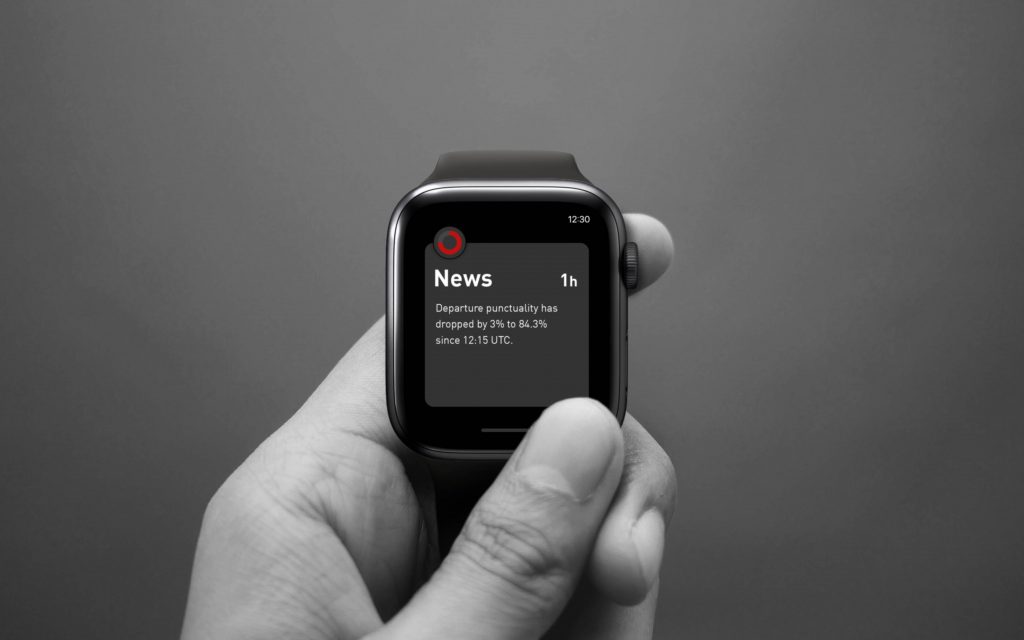Today we want to focus on upcoming technological trends that —from our point of view— will play an important role in 2020. Probably not surprising, each of the three trends is related to mobile usage. And besides the specific trends, we discuss in the following, mobile usage can be seen as the continuing significant trend when it comes to KPI usage.
Of course, airlines will —for a good reason— continue to use large video walls and TV screens to display KPIs. This absolutely makes sense to create awareness across a department (OCC, HCC, etc.) or user group.
However, when it comes to personal usage, the mobile phone (or tablet) will continue to become the preferred tool — instead of laptops or computers. Actually, this is not a KPI-specific trend but a trend you can observe in all areas.
Here are two charts that describe how the usage of mobiles already dominates our day.


Since this global trend will continue, airline KPI solutions have to meet these requirements and conquer smartphones and tablets even more aggressively than in the years before.
The fundament in this context are dedicated apps for smartphones and tablets that provides the possibility to monitor KPIs and information in real-time.
We wrote a lot about seamless integration and the necessity of a mobile-first strategy when it comes to airline KPIs. Therefore, this is something we consider as a basis. If you want to get a better feeling for this, check out our aWall product pages.
Based on that fundament, we see three major trends that will dominate the next year and simultaneously hold an enormous potential.

Technological KPI Trends: Ultra-seamless integration
Seamless integration describes the provision of dedicated apps that are tailored to the specific device — in our case, smartphones and tablets. To achieve optimal integration, we think it is essential to take the next steps.
With ultra-seamless integration, we define measures to even tighter integrate the airline KPI app into the smartphone/tablet.
iPhone Widget usage
You may know the widget functionality of iPhones. If not, swipe to the right on the iPhone (even when it’s locked). You get a very comprehensive overview of selected widgets.
Depending on your configuration, you can see the next meeting or weather information. The cool thing is: Widgets provide a quick summary in a super-easy to access way.
You don’t have to unlock the phone, open an app, and probably login. In case the content of a widget alerts you, you can simply click on the widget and the several apps open.
Widgets are a straight-forward and powerful functionality that even further integrates an app and content. Below you can see our very, very initial (actually it was the first) mockup we used to discuss this idea.

That means you have your most crucial airline KPIs directly shown in a widget, accessible with just one gesture (swipe to the right). And if a KPI alerts you, you click on the widget, and the app opens. That’s what we call ultra-seamless integration.
This is just one example of many. As mentioned earlier: The core idea is to utilize smartphone and tablet functionalities to integrate KPI apps into the devices further — and thereby massively improve usability.
Just dream for a second
Instead of starting your laptop, connecting to your corporate network, starting a web browser, selecting a bookmark, doing the login, selecting the correct dashboard to have a look at your KPIs — you swipe to the right on your iPhone.
Technological KPI Trends: Smart Alerting
What’s even better than swiping to the right? It is getting actively alerted when something happens. This is what the second trend we forecast for 2020 is about.
The trend is tightly linked to growing mobile usage of KPI solutions — however, it requires a lot of work in the backend. The basic idea: You send out alerts whenever a KPI changes significantly.
For example, the OTP drops by 3% compared to the last hour; smart and automated alerts are sent out directly to the mobile device of relevant stakeholders. Another example in this context is about sending out important and smart updates.
Here are two examples: The number of passengers until noon is 5% above the daily average. Or this misconnex quota is 2% less compared to the last three days. I think you’re getting the point. And actually, the number of use cases are limitless.
Technological KPI Trends: Smartwatch
Smartwatches, for example, the Apple Watch but also devices from other providers, will —from our point of view— gain increasing importance in 2020.
Smartwatches are continuously becoming an essential part of many people’s life. As mobiles did 15 years ago, we are currently witnessing the advent of smartwatches. And this will have an impact on airline operations KPIs too. With a market size of $9 billion back in 2017, current forecast estimate a volume of more than $30 billion in 2025 (Allied Market Research).
In other words, the market size is expected to grow by 15% — annually.
Although many airlines are still trying to incorporate smartphones into their operations KPI framework, the frequency of discussions I’m having with airliners about smartwatches is steadily increasing.
Since the usage of smartwatches is different, you should think about not bringing the entire information onto the smartwatch. Instead, we see the idea of Smart Alerting as a primary driver for smartwatch usage. The charming aspect: You don’t need to develop a native smartwatch app.
How could that look? I give you an example: Instead of trying to visualize the real-time on-time performance KPI on smartwatches, you send out the alerts mentioned above whenever this KPI changes significantly.
Here’s an example we’ve developed with regards to the aWall

Conclusion
Summarized we strongly believe that tailored, personal usage of KPIs will play a more dominant role in 2020 and consecutive years. Therefore, it is more than ever important to seamlessly provide the required information and to make it accessible as easy as possible.





